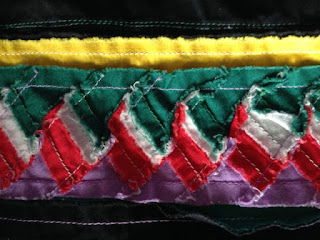The technique is to first stitch long, parallel stripes of colorful solid cottons. These strips are then cut vertically across the stripes, either perpendicularly or diagonally. Then the little bits are offset or flipped, stitched back together, and then finished with edge strips. It didn't happen on this skirt, but sometimes pieces from several base strips would be combined into a more complex design.
Here are some shots of the reverse, so you can be amazed by all the tiny bits of fabric. This is a technique that's really only possible with a sewing machine and with this clever kind of mass production. Can you imagine cutting and stitching and knotting off each piece individually by hand?!
On top of all that patchwork precision, there are these amazing little pleats at the top of the skirt where it is attached to the waistband.
This little doll (she's just 4" tall) shows the whole traditional Seminole outfit. Along with the patchworked skirt (though she's too tiny to have actual patchwork), there would be a short cape, beaded necklaces, and a stand-up hair-do. The hair was styled over rolls and boards, the bigger the better it seems. The long skirts and little capes were inspired by Victorian styles. There are also patchworked shirts and traditional short skirts for the men.
The doll's body is made of palm fiber. This one is nicely labeled. She's likely a souvenir of someone's long ago vacation to southern Florida. The colors of her outfit look to be 1940s. I found her at an estate sale quite a few years ago.
The Seminoles have a long history of persecution. In fact, there wouldn't be a Seminole people if it were not for decades and decades and decades of persecution. Members of the Creek and other tribes in what would become the southeastern US fled into Florida as European settlers arrived, grabbing land and spreading new diseases. They joined with the local Florida peoples and with escaped slaves and settled in the swamps that the Europeans didn't want. After many early wars and skirmishes, their rebelliousness and the harboring of escaped slaves became a worry for the newly formed US. In the early 1800s many of the people were marched westward on the infamous Cherokee Trail of Tears, a forced resettlement plan in which many, many people died. History has it that a mere 300 people were able to hide deeper in the swamps and survive. Their incredible tenacity amidst the whole uprooting and mixing process lead to a new people and a new culture. In fact, the word "Seminole" comes from the Spanish and then Muskogee word for "wild ones."











No comments:
Post a Comment